Charles Botterill, 1825 – 1894
by Brian Stevenson
last updated September, 2015
Charles Botterill is best remembered for two devices he invented for the microscope during the late 1870s:
His “trough” (or “zoophyte trough”) consists of two glass plates, separated by a rubber spacer, and held together by two brass or vulcanite plates (Figures 1-3). The Botterill trough can hold aquatic specimens in a deep, thin column of water, permitting the microscopist to view objects over an extended period of time.
Botterill’s “life slide” is a single brass plate into which a circular space is inset, and with a circular well at either side (Figures 4 and 5). Two circular glass slips are placed in the large space, with specimens between. Water can be added to one of the side wells, then drawn across the specimen by applying suction to the other side wells, thereby keeping the specimen alive. One can also add dye to one well, and then draw it across the specimen.
I did not find any records of Botterill patenting either device. Both were commercially produced by several manufacturers, and sold by retailers well into the 20th century (Figures 6 and 7).
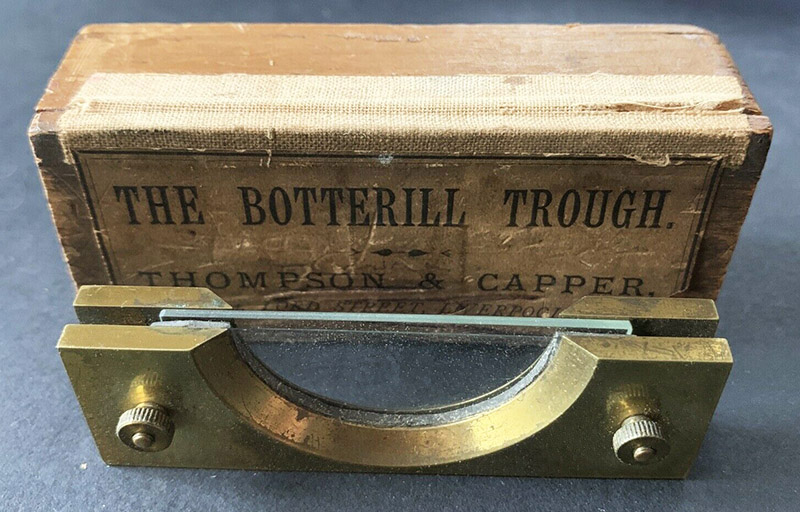
Figure 1.
An early brass Botterill’s trough, commercially produced by Thompson and Capper, Liverpool. Botterill originally produced his trough with brass plates, saying, “I have not tried vulcanite, which no doubt has advantages in some cases, as for instance where marine organisms are under examination, but for general use I prefer brass, as it allows thinner plates to be used, and a flatter bevel consequently to be obtained; this is an advantage when higher powers than the one-inch are used”. The trough measures 3 inches wide x 1 inch high. Images adapted from an internet auction site, for nonprofit, educational purposes.

Figure 2.
Another brass Botterill’s trough, produced by J.J. Marr, Liverpool. Images adapted from an internet auction site, for nonprofit, educational purposes.
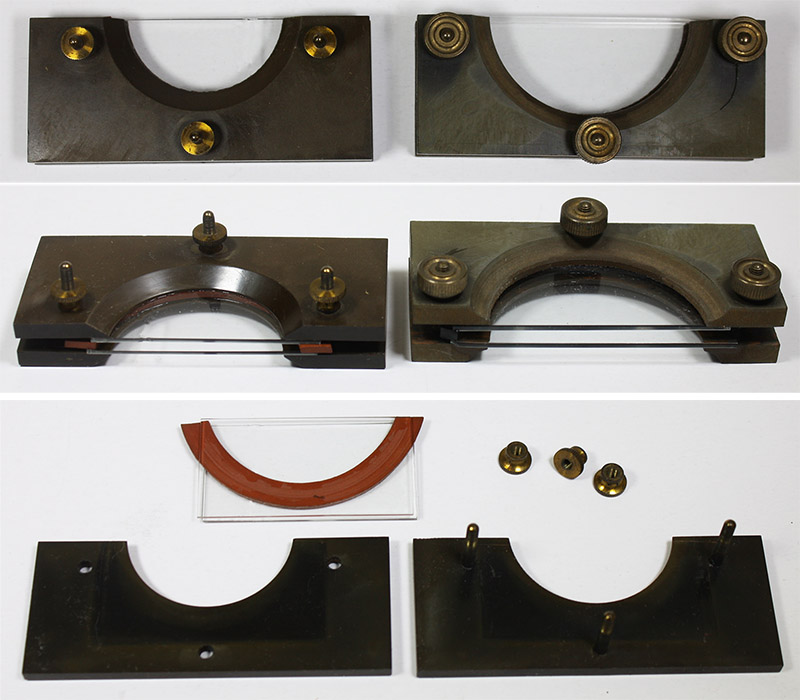
Figure 3.
Two commercially produced Botterill’s troughs, made of vulcanized rubber (vulcanite). Both measure 3 inches wide x 1 inch high. A thin rubber semicircle serves as a leak-proof spacer between the two glass plates. Botterill suggested using sections of rubber bands.
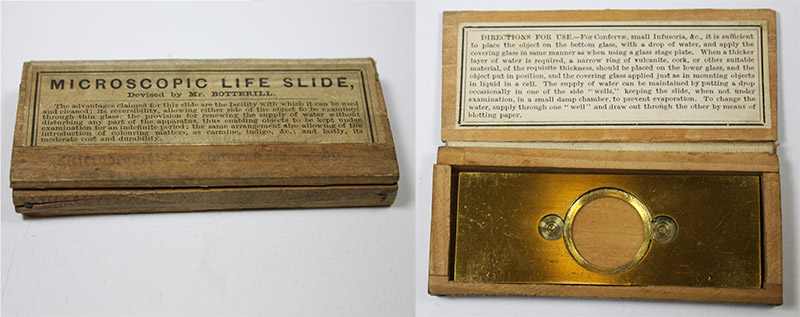
Figure 4.
An unsigned, boxed Botterill’s life slide. It is 3 inches wide x 1 inch high

Figure 5.
A Botterill’s life slide, manufactured by J.J. Marr, Liverpool, 3 x 1 inch.
Charles Botterill was born during the autumn of 1825, and was baptized on October 6 of that year at Saint Peters, Liverpool, England. Few records of his early life have been found. His father, Thomas, was listed as being a “gentleman” on Charles’ baptism record.
Charles married Emma (last name not known) in about 1850. Together, they had 6 daughters. Botterill was an agent for shipping companies that operated out of Liverpool. The family was relatively well-off, as all censuses recorded that they had domestic servants.
Botterill was elected to membership in the Literary and Philosophical Society of Liverpool on January 11, 1858. He joined the Liverpool Microscopical Society in 1878, and served as its President during the mid-1880s. He was further elected to membership in the Quekett Microscopical Club in 1881, and the Royal Microscopical Society in 1884.
There are several records in the minutes of the Liverpool Microscopical Society of Botterill presenting microscope slides at club meetings. I am not aware of any surviving examples of his work – if any readers can provide images or information, I will gladly share them.
Both the trough and life slide were invented about 1878, and described to the public shortly thereafter:
An 1880 description of Botterill’s trough, from The Journal of Microscopy, described both the implement and how to make it, “The advantages claimed for this form of trough … are the facilities it affords (1) for being cleaned, (2) for replacement of broken glass, (3) for arranging the objects in the best position for examination, (4) for reversal, and, lastly, the minor one that it will stand upright without support. It consists of two brass plates, which can be separated and screwed together again at pleasure, and hold between them two plates of glass, which are kept apart to any desired distance by India rubber. The plates - say 3" X 1 1/4”, and about 3/32 inch thick - should be of hard brass, so as to bear screwing up without bending, and so causing leakage. The curve of the trough may vary, but the semicircular - say 1 1/2" x 3/4" - is the most economical, as the two plates can be turned in the lathe at once, and this shape is also a convenient one for use. The bevel should be wide, so as to allow objectives to work close to the curve. The screws should be of equal length, that the trough may be level and steady when reversed, and be long enough to allow the plates to be set about 3/16 inch apart. The nuts should be milled, and as small as can be conveniently handled. The glasses may be semicircular, but oblong ones 2" x 1" seem to answer equally well. It might be an advantage to cement the lower one to the plate, but this is not essential. The edge of the bottom glass should be even with the edge of the plate, and the upper one about 1/16 inch from edge of plate, which will be found convenient when filling troughs from a dipping tube, &c. The best thing to separate the glasses is half of a circular flat india rubber band of the thickness which will give the required distance between the glasses. These bands, notwithstanding the sulphur, &c., contained in them, have not been found to act injuriously on living organisms. The trough may be put together, and then used in the usual way, or, as is generally better, the following plan may be adopted: The lower glass and rubber band being in their place on the lower plate, the object is arranged on the glass with needles in a little water, so that it may be best examined, and the upper glass and plate being put on, the whole should be screwed up, care being taken that the pressure (which need not be excessive) is equal, and the plates kept parallel; the trough can then be filled up with water”.
In response to another’s claim of novelty in 1881, John Howell published a defense of Botterill’s inventing the trough (although he got a few facts wrong), “New Zoophyte Trough - Mr. J. Campbell Christie, of Hamilton, N.B., is rather behind the times in his discovery of the new zoophyte trough he writes about in your issue for May. The trough he describes was invented seven years ago by Mr. C. Botterill, of Liverpool, one of the most active and successful members of the microscopical society of this city, and bears his name. I believe that the first were made in vulcanite, but experience showed that that substance was not stiff enough to give an equal pressure when screwed down, and Mr. Botterill improved upon his first invention by substituting brass for the vulcanite, and in this improved form they may now be had of Mr. J.C. Thompson (Thompson & Capper), Lord Street, Liverpool, Hon. Sec. of the Microscopical Society, also of Mr. J.J. Marr, optician, Moorfields, Liverpool. I have seen many notices of this invention, the credit of which has been given to one or another, but not to Mr. Botterill. Some claim it as their own, and others ascribe it to American ingenuity; but this and several other things, adding to the convenient manipulation of the microscope, are the result of his experience and ingenuity, and to him belongs the honour. The cost of the brass trough, I think, is 3s. each - John J. Howell”.
Botterill soon clarified Howell’s letter, “Improved Zoophyte Trough - Mr. J.J. Howell's note, which appeared in the June number of Science-Gossip, contains one or two errors which I wish briefly to correct. I invented the trough in question about three (not seven) years since, and after sufficient trial brought it before the Liverpool Microscopical Society. Some time afterwards it was brought before the Royal Microscopical Society and the Quekett Club (but not by myself), and was figured in the Journal of one or both. Subsequently an ‘improved’ form of the trough, in which vulcanite plates were substituted for brass ones, was brought before the Royal Microscopical Society by Messrs. Beck. I have not tried vulcanite, which no doubt has advantages in some cases, as for instance where marine organisms are under examination, but for general use I prefer brass, as it allows thinner plates to be used, and a flatter bevel consequently to be obtained; this is an advantage when higher powers than the one-inch are used. The ‘improved’ troughs I find are fitted up with thick glass, which is a mistake, as by using thin glass for both back and front a half-inch objective will focus to the back of the trough, and high powers, say up to the one sixteenth immersion can be used to examine objects on or near the front glass. Thin glass also allows a much better dark ground to be obtained with parabaloid or achromatic condenser. For keeping the glass apart I have found the ‘extra thick’ india-rubber bands to most generally useful; and in putting the trough together care must be taken to have india-rubber and glass perfectly dry, as otherwise there is a danger of a capillary leak and consequent disappointment – Charles Botterill, Liverpool”.
Botterill’s trough was produced through at least the mid-1900s. Catalogues indicate that it was primarily made out of vulcanized rubber (vulcanite) (Figures 6 and 7).
He first exhibited his life slide on October 7, 1879, to the Liverpool Microscopical Society, “Mr. Charles Botterill exhibited and explained a new form of life slide devised by him, adapted for the examination of a wide range of objects. The advantages claimed for this slide, are the facility with which it can be used and cleaned, its reversibility, allowing either side of the object to be examined through thin glass, the provision for renewing the supply of water without disturbing any part of the apparatus, thus enabling objects to be kept under examination for an indefinite period, the same arrangement also allowing of the introduction of coloring matters, as carmine, indigo, etc., and lastly, its moderate cost and durability”.
The Microscopical News and Northern Microscopist wrote further in 1881, “For Confervae, small Infusoria, &c, it is sufficient to place the object on the bottom glass, with a drop of water, and apply the covering glass in same manner as when using a glass stage-plate. When a thicker layer of water is required, a narrow ring of vulcanite, cork, or other suitable material, of the requisite thickness, should be placed on the lower glass, and the object put in position, and the covering glass applied just as in mounting objects in liquid in a cell. The supply of water can be maintained by putting a drop occasionally in one of the side ‘wells’, keeping the slide, when not under examination, in a small damp chamber, to prevent evaporation. To change the water, supply through one ‘well’, and draw out through the other by means of blotting paper. Messrs. Thompson & Capper, of 4, Lord Street, Liverpool, were the original makers of this slide”.
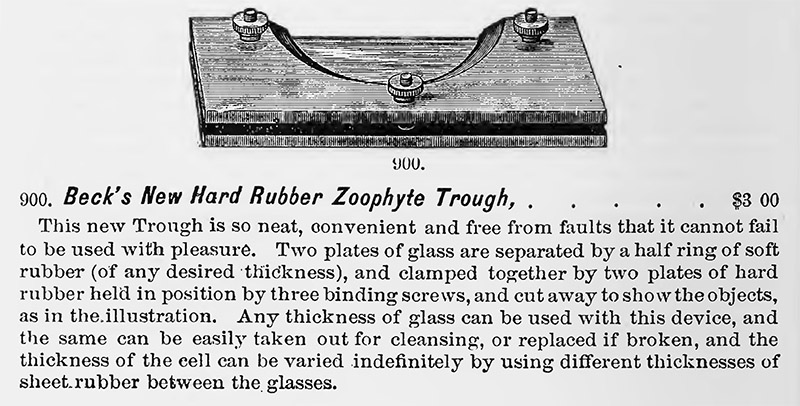
Figure 6.
An 1882 advertisement for a Botterill’s trough, sold (and appropriated by) R. & J. Beck.
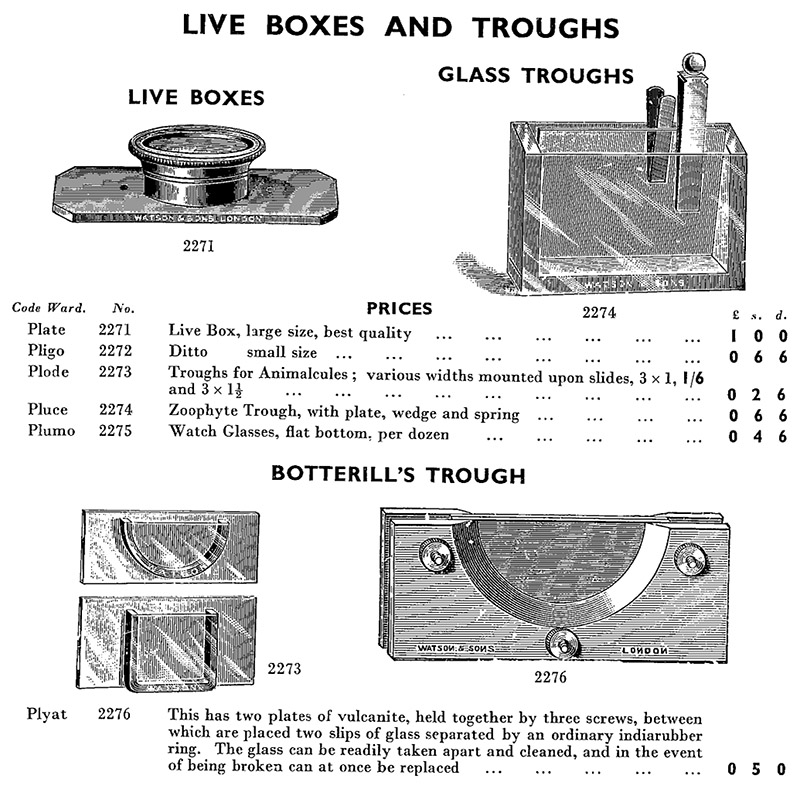
Figure 7.
Advertisements for Botterill’s trough and similar implements from Watson & Sons’ 1910 Catalogue.
Resources
American Journal of Microscopy and Popular Science (1879) Report of the October 7, 1878, meeting of the Microscopical Society of Liverpool, Vol. 4, page 186
Botterill, Charles (1881) Improved zoophyte tough, Hardwicke’s Science-Gossip, Vol. 17, page 160
Botterill, Charles (1884) Address of the President, Liverpool Microscopical Society, Microscopical News and Northern Microscopist, pages 57-68
Cross, M.I., and M.J. Cole (1903) Modern Microscopy, third edition, Balliere, Tindall, and Cox, London, pages 117-118
Davis, George (1889) Practical Microscopy, New and Revised Edition, W.H. Allen & Co, London, pages 240-248
England census, birth, marriage, and death records, accessed through ancestry.co.uk and familysearch.org
English Mechanic and World of Science (1881) Botterill’s microscopic life slide, Vol. 33, page 298
Howell, John J. (1881) New zoophyte tough, Hardwicke’s Science-Gossip, Vol. 17, page 135
Journal of Microscopy (1880) Botterill’s live trough, Vol. 3, pages 148-149
Journal of the Quekett Microscopical Club (1879) Objects exhibited at the November 14, 1879 meeting “New form of Zoophyte trough, designed by Mr. Botterill, of Liverpool (exhibited by) Mr. W. Teesdale”, Vol. 6, page 38
Journal of the Quekett Microscopical Club (1879) Minutes of the May 27, 1881 meeting, Vol. 6, page 38
Journal of the Royal Microscopical Society (1884) New fellows, Vol. 4, page 498
Liverpool Microscopical Society, Eighteen Annual Report (1887) List of members
Microscopical News and Northern Microscopist (1881) Botterill’s zoophyte trough, Vol. 1, pages 142-143
Microscopical News and Northern Microscopist (1881) Botterill’s microscopic life slide, Vol. 1, page 202
Proceedings of the Literary and Philosophical Society of Liverpool (1858) “11th January, 1858 … Charles Botterill, Esq., was elected an Ordinary Member”, Vol. 12, page 65
R. and J. Beck Catalogue (1882) page 98
Scales, Francis S. (1909) Elementary Microscopy: A Handbook for Beginners, Alexander Eger, Chicago, pages 117-118
Water Life and Aquaria World (1949) Vol. 4, page 67
Watson and Sons Catalogue (1910) 36th edition, page 227






